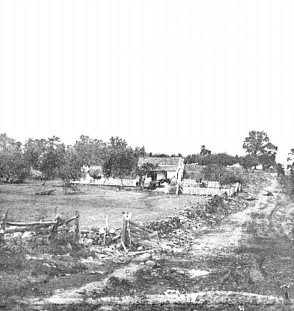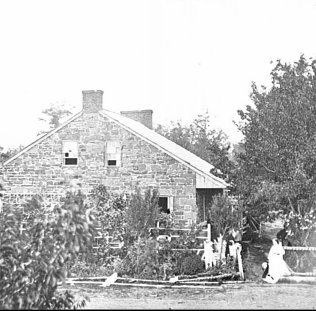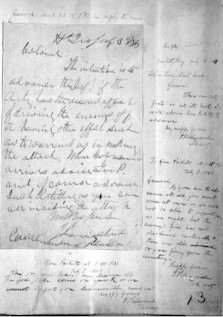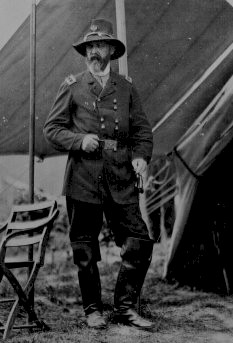| The Battle of Gettysburg: Day 3 Meade: 80,000 effectives holding three miles, 27,000 defending per mile or
fifteen per yard
Lee: 50,000 effectives holding five miles, 10,000 per mile,
six per yard
The fighting began at 4 A.M., when Slocum, attacked Johnson’s
divisions at the base of Culp’s Hill. After six hours of fighting, Johnson was pushed
back to Rock Creek, and Slocum regained control of Culp’s Hill.
Meanwhile, Longstreet was protesting Lee’s plan to
attack the Union center. He didn’t believe a charge against Cemetery Ridge would be
successful. Longstreet said “I have been a soldier all of my life. I have been with
soldiers engaged in fights by squads, companies, regiments, divisions and armies, and
should know as well as anyone what soldiers can do.” Lee ignored Longstreets
warnings, and the proceeded with the plan.
It was Pickett’s division that was to charge across the
open field from Seminary Ridge to Cemetery Ridge. Pickett was a young and inexperienced
general. He had never led his division into battle before, but was delighted at his chance
with glory and fame.
Supporting Pickett’s division were brigades commanded by
Trimble and Pettigrew.
Note from Alexander to Longstreet
“I will only be able to judge of the effect of our fire on the enemy by his return
fire, for his infantry is but little exposed to view and the smoke will obscure the whole
field. If, as I infer from your note, there is any alternative to this attack, it should
be carefully considered before opening our fire, for it will take all the artillery
ammunition we have left to test this one thoroughly, and if the result is unfavorable, we
will have none left for another effort. And even if this is entirely successful, it can
only be so at a very bloody cost."
Longstreet massed 143 cannons to fire upon the Union center.
At 1 P.M., the bombardment began. Immediately, Union cannons fired back. Shells came
streaking down on the Union lines as the men ran for cover.
“...the scene was indescribably grand.
All their batteries were soon covered with smoke, through which the flashes were
incessant, whilst the air seemed filled with shells, whose sharp explosions, with the
hurtling of their fragments, formed a running accompaniment to the deep roar of the guns.”
-Henry J. Hunt, Brevet Major General, U.S.A.,
Chief of Artillery, A.P.
During the cannonade, General Hancock calmly rode among his
men. Hancock said “There are times when a corps commander’s life does not count.”
As the cannons on both sides fired, the recoil dug itself
into the ground and caused the cannon to be aimed at a higher angle. This caused the
shells to travel farther and miss their targets. Rather than punishing the Union front
lines, the shells fell behind them, blasting those in the rear of the army. Meade’s
headquarters was bombarded, and the General was forced to move his headquarters after a
staff member was wounded in the neck and an orderly was torn in two.



|
On the Confederate side, the Union cannons also
missed their targets. Rather than hitting the Confederate guns, the shells flew over them
and blasted Longstreet’s men who were waiting to charge. Around 2 P.M., the Union artillery slackened their fire to conserve
ammunition for an expected attack. Because the smoke was so thick, the Confederate
cannoneers could not see what they where hitting, and assumed most of the Union guns were
destroyed.
By 3 P.M., the artillery duel was over. It was the largest
artillery duel of the war. |
Pickett went to Longstreet and asked, “shall I advance?” Longstreet said
nothing. Pickett replied “I shall lead my division forward, sir.” Pickett went
to his men from Virginia and said “Up, men, and to your posts! Don’t forget
today that you are from Old Virginia!” Pettigrew to his North Carolinians, said
“Now, Colonel, for the honor of the good Old North State-forward!” Marching out
into the open field from Seminary Ridge to Cemetery Ridge were 12,500 Confederate soldiers
shoulder to shoulder, in parade formation.

| "We were supporting Pickett's left, and the heavy
artillery fire come from both sides, the field in front of us looked like plowed ground
where the shells hit". |
"They went down like blackbirds. When Pickett
charged we went too. The corn was knee high. We carried the flag. We went up the hill but
we could'nt stay there. It was a hot day, and we fought." |
As they silently advanced, cannons from Cemetery Hill and
Little Round Top opened fire. A Union artillerist said “We could not help hitting
them at every shot.” The Union guns smashed the brigades “with fearful effect,
sometimes as many as ten men being killed and wounded by the bursting of a single shell.”
The explosions formed gaps in the advancing Confederate lines. In the midst of hell
falling down in the form of metal, Pickett stopped his troops, and gave the orders to
redress the lines. Men stepped on their dying comrades and filled up the holes were the
shells had fallen, and continued their march to Cemetery Ridge. They walked at a fast
pace, toward the Union center, marked by a clump of trees. As they came closer, the Union
cannons at Cemetery Ridge fired canisters, blasting huge holes in the lines. Union
infantry hiding behind a stonewall opened fire, and sheets of bullets came down upon the
charging Confederates. All of Pickett’s brigade commanders were dead except for
General Armistead. Armistead with 300 men charged at a bent in the Union line known as the
Angle. The band of Confederates broke the Union line and charged into a bloody fight of
hand to hand combat and shooting at point blank range. Armistead cried “Give them the
cold steel.” As he placed his hand over a captured Union cannon, Armistead was
killed. Hancock and reinforcements arrived in time to patch up the hole in the Union line.
Hancock was shot in the leg but remained present at the angle until the position was
secure. All of the Confederate men who broke into the Union lines were captured or killed.
The survivors of Pickett’s charge began wandering their way back to Cemetery Ridge.
| The Union soldiers began cheering and displayed the captured
flags of Confederate regiments. Of the forty-two regiments in Pickett’s charge,
thirty lost their flags to the Union men. During the celebration, Pleasonton and Hancock
went to Meade and proposed a counter-attack. Meade was against it and told them “We
have done well enough.” Throughout the
fighting, Pickett was not present. Instead of commanding his troops on the field, Pickett
stayed back at his headquarters waiting for the results. In 50 minutes, the 12,000 man
charge suffered 10,000 casualties. After the assault, Pickett went to Lee. Lee was
expecting a counter-attack from the Union army and ordered Pickett to ready his division.
Pickett said “General Lee, I have no division, now.” |
 |
|

